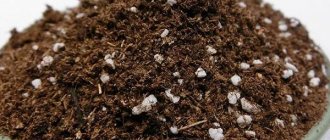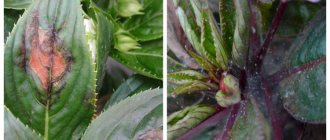Indoor violets are demanding and delicate plants, sensitive to even the slightest temperature changes and the presence of drafts, changes in lighting and soil quality.
Any disease of these flowers is immediately reflected in their appearance. The leaves become covered with plaque and spots of various shades, which determine the cause of the poor condition. Violet diseases manifest themselves as spots on the leaves; every gardener needs to know how to treat them and prevent their occurrence in the future.
Types of powdery mildew, prevention and treatment methods
Downy and true powdery mildew are common causes of death of indoor violets. Both diseases are fungal in nature. In the case of powdery mildew, the causative agent is powdery mildew (Erysiphales). Downy mildew is caused by Peronosporaceae fungi, a family of Peronosporaceae.
Powdery mildew
Powdery mildew
You can understand that a violet is sick with powdery mildew at the initial stage of the disease. A light coating of white on the leaves and petioles should alert you. It looks like the plant has been lightly dusted with flour. The progression of the disease is accompanied by damage to all parts of the plant by ulcers. The leaf surface becomes uneven.
Trending Wisteria for the middle zone: dreams come true!
At the final stage, there is a general depression of the violet: it stops growing, weakens, and dies. There are many causes of powdery mildew infection. Most often, the fungus multiplies on flower plants that are weakened due to poor care. Powdery mildew is caused by excess nitrogen in the soil. Possible routes of infection:
- from another diseased plant;
- fungus-infected soil;
- a dirty, contaminated instrument used for transplanting and propagation.
Treatment
At the first signs of illness, begin treating the diseased violet. First, inspect the flower, pinch off all damaged leaves. Treat the soil and leaves with a fungicide. Fundozol and Topaz are suitable for processing violets. These fungicides do not damage delicate leaves; the spray solution should be slightly warm. Place the violet in a warm, dark place. Keep it in the dark until completely dry. This measure will prevent sunburn on the leaves.
Prevention
Monitor the balance of nitrogen, potassium and phosphorus in the soil. Use fertilizers with a high percentage of potassium and phosphorus to feed the flower. Before transplanting (planting) violets, treat the soil with a fungicide:
- Previkur;
- Infinito;
- Thanos.
Downy mildew
Downy mildew
Treatment and preventive measures are the same as for powdery mildew. Signs of the disease differ:
- the first stage is a silvery or white coating on the bottom of the leaf blade;
- second stage - spots on the upper surface of the leaves, the color of the spots is light green, brown, reddish;
- third stage - if left untreated, the flower dies.
Important to remember! High humidity accelerates the course of the disease and promotes the spread of downy mildew.
Incorrect lighting
Violet does not like direct sunlight. If the plant is constantly exposed to sunlight, the plant may get burned: round-shaped spots colored yellow will begin to appear on the leaves. Over time, the stain turns brown. Sometimes holes appear in the center of the leaves.
To understand that the plant has received a burn, you should pay attention to the place where the spotting appears. When a burn occurs, spots appear on the side of the window.
In such cases, it is necessary to remove all affected leaves and inflorescences, and remove the plant to a place without direct sunlight. Window sills facing northeast and northwest are suitable for growing violets.
Rust
Rust
You can lose your favorite violet due to the fungus Phragmidium, which causes rust - a dangerous disease of indoor plants. This disease should be recognized and treated in the early stages. The likelihood of violets becoming infected with rust is higher during the winter-spring transition period. Lack of sunlight, reduced immunity for this reason, and the presence of fungus in the apartment are the main causes of rust.
Signs of rust are clearly visible in the photo. Yellowish spots appear on the outer surface. Turning the leaf over, you can see yellow pustules - colonies of the fungus. When pustules rupture, fungal spores spread throughout the room and infect other plants. Having discovered signs of rust on your violet, you need to begin emergency treatment of the flower:
- remove and destroy leaves affected by the fungus;
- isolate the flower from other indoor plants;
- treat the leaves with a fungicide.
Help against rust: “Fitosporin-M”, “Baktofit”, “Topaz”. If the form is advanced, treatment may not help. In this case, destroy the plant and discard the flower pot.
A set of measures against diseases and pests
There are simple rules of prevention, the observance of which will protect Saintpaulia from infection with fungus and parasites:
- isolation of new flowers from domestic ones for 1-2 months;
- avoiding contact with field plants and fresh vegetables;
- regular treatment with water at room temperature and inspection;
- wet cleaning in places where violets are placed;
- timely processing of pots and pallets;
- compliance with basic care requirements.
Diseases and pests that violets suffer from can be very dangerous and lead to their death. The main condition for good immunity is proper care and maintenance. This will help to grow a healthy and flowering plant.
Root rot
Root rot
Alarm signal - the violet does not bloom. It can be assumed that a violet has root rot if, with a damp substrate, the lower leaves of the flower, which have lost their elasticity, are flaccid, and the petioles are soft to the touch. The cause of violet root rot is fungi (phytopthora, pythium), and their active reproduction is provoked by the incorrect content of the flower, to be more precise:
- lack of drainage hole in the pot, excessive watering;
- poor quality soil (taken from the garden);
- cooling the soil in the pot;
- abundant watering on dry soil.
According to statistics, 75% of all violet diseases are root rot. To avoid this unpleasant disease, take the advice of experienced gardeners as a rule - water in small portions in case of violet transplantation and after a forced long drought. Water every few days until the plant adapts after the stress it has suffered.
If you suspect root rot in your violet, do not hesitate, start resuscitating your favorite flower. First of all, remove it from the pot and inspect the roots. The absence of white roots confirms the diagnosis. The next step is to remove the lower leaves and cut off the root part. If there are brown spots on the stem cut, cut the stem higher. The stem that is not damaged by rot has a purple tint. If the entire stem is damaged by rot, destroy the plant.
When we reach the healthy part of the stem, remove the lower 1-1.5 cm of leaves, spray with fungicide, leave to lie for 30 minutes and place in a substrate (vermiculite, water, soil) to form new roots. It is better to use moistened vermiculite and put a transparent bag on top of the flower. Take the container with the flower to a cool room and use a fluorescent lamp for illumination. After new roots appear, plant the violet in a new pot filled with soil.
Where do diseases come from?
The most common causes of the disease are:
- Wrong soil. Infection is observed in flowers grown in garden or forest soil. It is best to purchase a special substrate for violets in the store.
- A lack of potassium, phosphorus and other minerals can lead to the formation of fungus.
- Excess nitrogen. Excessively nitrogenous soils lead to intensive development of fungal diseases.
- Improper care provokes the formation of diseases. Plants should not be kept in high humidity, too low or high temperatures, or in insufficiently lit areas.
Bacteriosis
Bacteriosis
At the height of the summer heat, many gardeners begin to die of violets from bacteriosis. It is almost impossible to save flowers. Signs of violet bacteriosis:
- the appearance of brown spots on stems, petioles, leaves;
- the leaves, starting from the bottom, change color, becoming dark;
- the leaf tissues soften and the flower dies.
Diseased flowers die quickly (from 2 to 30 days), the disease can spread to other plants. More often, violets suffer from bacteriosis from careless flower growers, who either dry out or flood poor plants. The most critical month for bacteriosis is July. In the heat, violets need to be shaded from the sun, when leaving to rest, organize wick watering. In spring, replant violets into pots with new soil mixture. At the beginning of summer, treat violets with Epin.
Violet disease - vascular bacteriosis: video
Late blight
A sign of late blight is brown, dry spots on the leaf part of the plant. The spots spread very quickly. In the shortest possible time, the plant tissue undergoes necrosis and the rosette withers.
If the top of the rosette is not damaged, then you can cut it off, treat it with a fungicide, cut off the damaged areas and root it. Individual leaves are also suitable for rooting.
The remaining part of the flower is destroyed. Neighboring flowers must be treated.
Indoor violets are demanding and delicate plants, sensitive to even the slightest temperature changes and the presence of drafts, changes in lighting and soil quality.
Any disease of these flowers is immediately reflected in their appearance. The leaves become covered with plaque and spots of various shades, which determine the cause of the poor condition. Violet diseases manifest themselves as spots on the leaves; every gardener needs to know how to treat them and prevent their occurrence in the future.
Pests of violets
Leaves, buds, and petioles of violets need to be inspected regularly. Especially in spring and summer, when the windows are open for ventilation. Be mindful of insect pests when purchasing a new potted plant from a flower shop and when decorating your home with cut flowers. It doesn’t matter whether they were cut in your own garden or in an industrial greenhouse. With flowers and soil for air transplanting, there is a chance of pests getting into your blooming violets. The most common aphid pests are:
- Mites (flat beetles, cyclamen, spider mites).
- Scale insect (false scale).
- Nematodes.
- Thrips.
- Aphid.
- Mealybug.
There are many pests that parasitize violets. Photos of insects and violets damaged by them will help to identify the parasite in time and choose the right method of control.
Ticks
Ticks feed on violet juice. The size of ticks is so small that it is difficult to see them with the naked eye.
Spider mite
Spider mite
The most common type of mite that settles on the petioles and leaves of indoor violets is the spider mite. We saw the finest white cobwebs on the petioles, buds, and leaves - this was a spider mite on the violet. The poor plant loses its decorative appearance due to loss of juice. Deformed brown leaves appear on the bushes. They dry out and fall off.
Cyclamen mite
Interesting on the topic:
Why imperial hazel grouse don’t bloom in spring: what to do...
Jan 27, 2022
Growing hazel in the country
Jan 24, 2022
Cyclamen mite
If the violet does not grow, has stopped blooming, the young leaves are covered with yellow spots and are compacted - a cyclamen mite has settled on the flower. It settles in at the top of the outlet.
Flat beetle mite
Flat beetle mite
Flower growers rarely encounter this mite on their violets. Signs of the presence of a flat beetle mite on a violet are leaves curled inward. The leaves gradually wither, dry out and fall off. The violet may die.
Folk recipes for ticks on violets
If you see the first signs of a mite on a violet, don’t wait, use a simple folk trick first. You can take vodka or alcohol. Use a cotton swab soaked in alcohol to wipe the petioles and leaves of the violet.
After a few days, spray the violet with an infusion of onion peels. Pour 80 g of onion peels into a 3-liter jar and pour boiling water over it. After a couple of days, the infusion can be filtered and used for spraying. Treat all flower plants in the room for prevention.
Chemistry against ticks
Traditional recipes are effective at the initial stage. When the concentration of insects is threshold, the flower is threatened with death, the only way out is chemistry. Use acaricides - special preparations to combat ticks:
- Apollo is an enteric contact drug. Apollo destroys tick eggs, kills larvae, and inhibits the sexual activity of adults.
- Neoron is a new product that acts on adult ticks from the inside. Duration of exposure is 10-40 days.
- Fitoverm is an effective insectoacaricide with enteric contact action. Valid for up to 20 days from the date of processing.
Shchitovka
Shchitovka
It is difficult to get rid of scale insects and false scale insects on violets. One female scale insect that lands on a flower lays many eggs within a few days. Larvae (vagrants), when born, feed on violet juice. The lower surface of the leaves of an infected violet is covered with red-brown scutes. Yellow spots are visible on the upper surface of the leaf blade. Adults secrete a sticky mass in which sooty fungus multiplies. Sometimes it's easier to destroy the violet.
Adults are not afraid of insecticides, so they must be removed mechanically. To do this, you will need a cotton swab moistened with the preparation: “Aktellik”, “Aktar”, “Karbofos”. You can treat the leaves with soapy water by dropping kerosene into it; it’s even easier to take 1 liter of water and pour 2 tbsp into it. l olive oil. Treat all violet leaves and petioles with the resulting oily solution.
Thrips
Thrips
The first sign of thrips on violets is scatterings of pollen, the second is yellow tracks on the leaves. A recipe from an experienced violet lover will help you get rid of thrips on violets. Take any flea shampoo (25 ml) and 1 ampoule of Fitoverm-M. Dilute them in 5-6 liters of water.
Wrap the violet (pot) in a plastic bag so that the soil does not fall out. Wash violet leaves in running warm water. Dip the socket into a bowl of soapy water for 10 seconds. After the procedure, water the soil in the pot with a solution of 2 preparations: Fitoverm-M, Aktara, prepared according to the instructions.
Nematodes
Nematodes
Nematodes are thread-like, transparent worms (up to 2 mm). They live in the soil and infect the root system. Signs of a violet affected by nematodes:
- elongated, thickened stem;
- shortened petioles, petioles completely absent on the upper leaves;
- the leaves acquire an unnaturally dark green color and become dense;
- the edges of the leaves curl inward;
- flowers are small, ugly;
- thickenings on the roots (galls);
- roots are brown and black.
It is impossible to get rid of nematodes; prevention saves. When planting, you can add crushed dry marigold petals and peat to the soil. Nematodes do not like peat. Water the violets with marigold infusion or water infused with peat. Nematodes do not like vermicompost. A substrate based on vermicompost (Terra-Vita) is an ideal option for violets. Use new pots for replanting; treat old ones with a strong disinfectant.
Mealybug
Mealybug
Mealybugs can be seen with the naked eye; the size of the insect depends on the variety (3-6 mm). Damage to violets is caused by adults and their larvae. Habitats:
- buds;
- young leaves;
- young shoots.
An infected violet is stunted in growth. On damaged surfaces you can see a white coating that looks like cotton wool. In the later stages, the fungus multiplies on the sweet secretions of insects.
You can get rid of scale insects on violets. Moisten the brush in a soapy solution and clean all parts of the plant from insects and plaque. Prepare a solution of green soap. Grate 10 g per liter of water and stir. Spray the violet. It is necessary to process 3 times with an interval of 7 days.
Aphid
Aphid
Aphids on violets are visible to the naked eye; they form their colonies on the inner surface of the leaves, in the buds. Adults and larvae suck the sap, inhibiting the plant. The fungus multiplies on the sticky secretions of aphids. Aphids are carriers of viruses. Signs of violets affected by aphids:
- the crown part of the flower is deformed;
- ugly shaped flowers;
- buds do not develop;
- leaves are curled.
It is not difficult to fight aphids, especially at the very beginning. If small green or black insects appear (the color depends on the type of aphid), wash the violet with soapy water. Tear off leaves that have lost their shape. After a few days, repeat the treatment. In advanced cases, use chemistry:
- Aktellik;
- Fitoverm;
- Intavir.
When spots appear on leaves
Spots on violets primarily affect the leaf blade, since it is all covered with delicate fluff. The villi react to external influences, signaling a change in color, first in small areas of the leaves, and then throughout the entire plant.
The primary reason for the appearance of stains on Saintpaulia is external factors. It is enough to change the position of the pot and place it on a more illuminated windowsill, and burns will begin to appear on the flower. And from a draft, a light rim appears, moving over time to the central part of the plate.
Internal diseases of the plant are no less common, one of the symptoms of which is spots. Leaf disease occurs when there is an excess of moisture or severe drying out of the soil. It can develop from a lack of essential vitamins if the wrong fertilizer is used.
The most dangerous cause is considered to be fungal infection due to improper maintenance or transfer from a diseased specimen. It is quite difficult to detect mycosis in the early stages, since the first symptoms appear from the bottom of the lower leaves. In more visible areas of the plant they can be seen in more complex forms.
Another reason why Saintpaulias become spotted may lie in the colony of insects. Diagnosing unwanted residents is simple - look at the mites themselves or their ovipositors through a magnifying glass. In this case, a characteristic difference from other diseases is the presence of holes in the spot area.
Growing problems
Beginners who start growing violets often have problems caused by improper care. The most common complaints:
- spots appeared on the leaves;
- leaves wither and dry;
- The violet root is rotting.
Spots on leaves
Why do yellow or brown spots appear on violet leaves? Most likely, the violet is exposed to direct sunlight, and the spots are sunburn. They save the violet in different ways: they stick stained glass film on the glass, shade it with translucent roller blinds, and transfer it to the windowsill of the north window. Ideally, violet loves diffused, not bright light. Spots on leaves can occur:
- due to dry (too humid) air;
- insufficient (excessive) watering;
- due to excess fertilizers, especially nitrogen;
- using cold water for irrigation.
Elite varieties of violets should be grown on a rack equipped with an artificial lighting system.
Why do leaves wither and dry?
The edges of the leaves dry out and darken for four reasons. The first reason is overflow. The second possible reason is a lack of nutrients in the soil. Reduce watering, water only when the top layer dries. If the problem is poor soil, feed with any fertilizer for ornamental plants. The third reason why the edges of the leaves may dry out is poor soil: dense, heavy, or when replanting the flower it was too compacted around the roots. The violet leaves are still drying from the draft; she categorically does not like it.
The root is rotting
Usually the roots of violets rot due to overwatering or acidic soil. Provide the plant with bottom watering. To do this, use pots with holes in the bottom and place them in a tray. Pour water only into the pan; after 30 minutes, be sure to drain the water from the pan. Use purchased soil for Saintpaulias. Try to save the overwatered violet by re-rooting.
Most diseases of violets are caused by improper care. If optimal conditions are created for the violet, it will bloom most of the year. Violet loves eastern windows, artificial lighting in winter (10-12 hours), moderately humid air with a temperature of 18 to 24 ° C, a small pot (5-7 cm in diameter), light and nutritious soil.
Basic rules of care
Caring for violets at home is not difficult, the main thing is to comply with the necessary requirements for the following parameters:
- Choosing soil and pot. Soil with neutral PH is suitable for Saintpaulia. You can use a purchased mixture or prepare it yourself from humus, turf, pine soil and peat with the addition of baking powder. Pots should be chosen small, with a diameter smaller than the rosette of a flower.
- Placement and light. Violet loves light, but not direct sunlight. Therefore, it is better to place pots on the western or eastern side. There should be at least 10 hours of daylight, so in winter you will need fluorescent lamps.
Variety of homemade violets - Saintpaulia
- Temperature and humidity. The optimal temperature is 20-23 degrees, and in winter it can be reduced to 18. On hot days, the room should be regularly ventilated, avoiding drafts. Air humidity should be at least 50%. Plants should not be sprayed. During the heating season, it is better not to keep flowers near radiators.
- Watering. Use water at room temperature and carry out the procedure as the top layer of soil dries. Do not allow water to stagnate in the roots; empty the tray in a timely manner. It is recommended to limit watering in winter.
- Fertilizer application. Fertilizing is carried out during the growing season and flowering, approximately 2 times a month.
Violet cuttings ready for planting in the ground
To propagate violets, the leafy part of the plant is taken. The cuttings are kept in water until roots form, then planted in loose soil under cover. Can be propagated by seeds.
Advice! If Saintpaulia was purchased in a store, it needs to be kept in isolation for some time. This will eliminate the possibility of infection of home flowers if the violet is sick.











